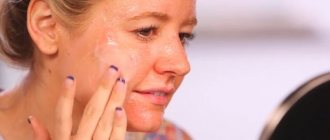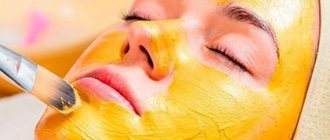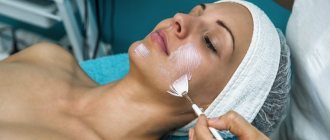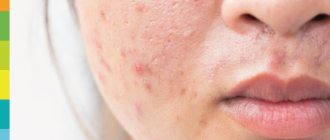Good day!!!
Today we will talk about the possibility of renewing our skin during the winter. As you probably guessed, we will talk about chemical peels that are loved by almost everyone! Do you love the peeling procedure as much as I do? If yes, then let's talk about the features of peeling, their diversity and how to choose a safe peeling? If not, then I will try to tell you in detail about this procedure and interest you, or better yet, try it! The main thing is that the chemical peeling procedure should be carried out by a specialist who knows how and understands what he is doing and why?
And what is peeling? Chemical peeling (chemoexfoliation) is a process of damage to the surface layer of the skin followed by exfoliation, which helps stimulate and regenerate processes and form new healthy cells.
Professional opinion
I. Dorofeeva, cosmetologist
“Most peeling methods can be quite dangerous, sometimes leaving the skin feeling like paper thin. To prevent the situation from getting worse, you should contact an experienced specialist. For the first time, you should still think carefully and choose a less aggressive peeling procedure. Medium peeling should be neglected for now. Besides this, there are other very effective procedures that may be enough to achieve results.”
Not all doctors have a positive attitude towards this procedure
❄
Retinoic peels belonging to the superficial category have gained particular popularity recently. Retinoic peels are also known as “yellow peels” or “weekend peels” (due to the short recovery period). The mechanism of action of retinoic peels is fundamentally different from the mechanism of action of other peeling agents. The retinoids included in the “yellow peeling” do not damage the skin, do not destroy living cells, and do not coagulate proteins. They interact with specific nuclear receptors of cells. Principles of action and types of chemical peels remove dead skin layers by stimulating the regeneration of young cells.
These receptors have been found in basal keratinocytes, melanocytes and fibroblasts. Thus, as a result of the effect of retinoic peels on the epidermis, the level of mitotic activity of basal keratinocytes increases, the processes of differentiation and keratinization, as well as melanogenesis are normalized, the synthesis of epidermal lipids and components of the intercellular matrix of the dermis is activated and stimulated, and the number of atypical cells is reduced. As a result, skin aging slows down, its texture improves, its relief is evened out, and a pronounced rejuvenating and brightening effect is achieved. In addition, yellow peel retinoids have a powerful antioxidant effect. Histological studies have shown that the stimulating effect of retinoic peels on the cellular structures of the skin persists for 4 months after the last application of retinoids. Other important reasons for the demand for retinoic peels are their atraumatic nature and high safety of use, a short post-peeling period and an extremely low rate of complications. Therefore, retinoic peeling can be carried out in the summer.
Patient reviews
There are different reviews about medium peeling. In most cases, patients see positive changes and are satisfied with the results. Sometimes the picture is clouded by complications.
The patient suffered complications.
I like the result of the treatment.
The patient sees an improvement in the picture, but the problem is not completely solved.
The patient sees the positive effect of exfoliation.
STAGES OF IMPLEMENTATION
Procedure protocol
Medium facial peeling is carried out as follows:
- First, we choose a method and make sure there are no contraindications.
- 2 days before the session, the use of fatty creams is limited, cleansing and degreasing with tonic is allowed.
- On the day of the session, the treatment area must be prepared in a special way: cleaned of dirt, grease and makeup.
- At the next stage, the composition itself is applied, strictly according to the procedure protocol.
- After the frost effect (a white coating representing denaturation of cellular protein) occurs, a peeling mixture neutralizer is applied.
- Finally, a moisturizing and protective mask is applied.
Post-session care
Care after a mid-peel (for example, TCA) is especially important, since any misstep during the rehabilitation period can negate all the benefits. The face may become red and swollen at this time, this is normal.
Photos BEFORE and AFTER
After the session, the skin peels off for 7 to 14 days . At this time, a crust forms on the damaged tissues, which should come off on its own. Under no circumstances should you tear it off, otherwise scars may form.
scrubs after a medium facial peeling!
You cannot wash your face with water for the first 2 days . Starting from the 3rd day, once daily washing with boiled water at a pleasant temperature with mild acidity pH 5-6 is allowed (regular soap is prohibited).
Simultaneously with washing, you can use pharmaceutical skincare products like Panthenol.
GlyDerm Gentle Face Cleanser
A non-greasy moisturizer can be used every 2-3 hours.
It is very important to use high-quality sunscreens with high SPF and PPD (special anti-cancer protection) to avoid the occurrence of hyperpigmentation.
What is the best way to prepare for the procedure?
One of the features of medium peeling is the mandatory preparation for exfoliation. Preliminary measures are determined in each case individually and depend on the condition of the skin, the depth and severity of the defects, and the age of the patient.
Today there are two methods of preparing for exfoliation:
- superficial peeling in a beauty salon (enzyme, fruit, Jessner, almond). Performed with low concentrated acids;
- using retinol-based cosmetics at home.
The measures considered thin and smooth the epidermis, increase cell rejection, increase the final effect and reduce the risk of developing undesirable consequences.
In addition to external effects on the skin, all patients without exception are recommended to take a course of antiherpes drugs, for example, Acyclovir.
Chemical peeling: what is it?
Cleansing the skin using special chemical compounds that, when applied to the epidermis, remove old cells. Once applied, the chemicals begin to cause certain reactions within the layers, revealing healthy skin that has not yet been affected by external factors.
Chemical peeling is used to correct existing changes and to prevent aging of the skin layers. After the procedure, the complexion improves, acquires a blooming appearance, and the number of wrinkles is reduced.
In medical practice, it is known that this chemical peeling can help with acne, dermatitis, acne and other skin diseases. In addition to the exfoliating effect, the procedure stimulates the body's protective properties. The production of elastin, hyaluronic acid and collagen returns to normal.
Cost of a session in the salon
The price of a medium peel, like most procedures performed by a cosmetologist, is determined individually. The cost depends on the amount of work, the cost of the existing composition, the need to use additional means, and manipulations. Cosmetologists rarely prepare individual mixtures and are not inclined to use budget “cocktails” with highly unpredictable results.
The most common option is to carry out the procedure with ready-made drugs from well-known brands. Average price range for intervention: 2–10 thousand rubles.
Indications and contraindications
The effect of medium peeling is most significant on mature skin, so the procedure is recommended for women over 35 years of age. It is at Balzac’s age that the first signs of aging appear, the structure of the dermis changes, gravitational ptosis develops, and the face loses its clear contours.
An indication for prescribing medium exfoliation can be not only age, but also serious skin defects. In addition to sagging tissues and deep wrinkles, these include:
- age spots, freckles;
- rosacea;
- post-acne;
- scars;
- photoaging;
- disturbed skin texture;
- stretch marks after pregnancy;
- dull complexion.
Medium peels are used not only for aesthetic correction of appearance, but also for therapeutic purposes. A course of exfoliation prescribed by a dermatologist can get rid of traces of solar keratosis, acne, and the results of dermatitis.
The excellent exfoliating and regenerating properties of medium peels allow you to expand the scope of their application. Acidic enzymes are often used to cleanse and soften the skin of the feet. The rough and dense dermis of the foot responds well to concentrated solutions, quickly getting rid of calluses and corns.
When planning to exfoliate, you should remember that medium peeling is a traumatic procedure and has a number of contraindications:
- herpes virus in the acute stage;
- pustular skin diseases;
- the presence of warts and moles at the site of exposure;
- feverish condition;
- oncology;
- pregnancy and lactation;
- tendency to form scars;
- individual intolerance to exfoliant components.
In addition to the factors discussed, a fresh tan obtained on the beach or in a solarium will be a limitation to exfoliation.










